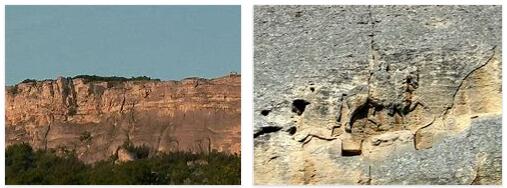
The rock relief at a height of 23 m is considered to be the most important early medieval monument in Europe and the oldest surviving testimony to the history of the First Bulgarian Empire. The equestrian relief probably shows King Khan Tervel (701 – 718).
Madara Horsemen: Facts
| Official title: | Rock relief of the rider of Madara |
| Cultural monument: | an early medieval rock relief as an “icon of the history of Bulgaria” at a height of 23 m on a 100 m high rock face; 2.85 m high equestrian portrait presumably of the ruler Khan Tervel |
| Continent: | Europe |
| Country: | Bulgaria |
| Location: | Madara Plateau, northeast Bulgaria, southeast of Shumen |
| Appointment: | 1979 |
| Meaning: | oldest surviving “document” in the history of the First Bulgarian Empire |
Madara Horsemen: History
| 681 | Establishment of the First Bulgarian Empire |
| 701-18 | Reign of Khan Tervel; Time of origin of the rock relief |
| 814-31 | Reign of Khan Omurtag; most recent inscription of the rock relief |
Triumph of victory
The region near the mighty Madara massif has been both a settlement area and a religious place of worship since prehistoric times. In the caves of the mighty rock, tools of Neolithic residents were found as well as references to a Thracian nymph sanctuary. The Romans also maintained a large property here.
So it is not surprising that a central monument of the First Bulgarian Empire was erected at this historically significant place, where an almost one hundred meter high rock face drops almost vertically. This rock relief, commonly known as the »Rider of Madara«, which – carved out of the steep rock face at a height of 23 meters – was once visible from afar, is the only such early medieval monumental relief in Europe. The almost life-size scenery shows a rider – followed by his dog – who is piercing a lion with his lance. Meanwhile heavily weathered by rain and wind and, moreover, robbed of its former plaster coating, of which only tiny remains have been found, the effect of this relief has meanwhile greatly diminished.
But how significant must the occasion once have been to carve out a relief from the rock face that was technically and artistically very elaborate for the time? Elaborate scaffolding structures probably had to be used, and the task of creating a monument with a long-distance effect was unprecedented in Europe at the time. Similar representations are only known from early Byzantine tapestries from the 6th to 8th centuries. Remnants of inscriptions in Greek, next to the monumental representation also carved out of the rock, facilitate the dating of the rider. The oldest is from the early 8th century, from the time of Khan Tervel. According to zipcodesexplorer, the young First Bulgarian Empire, which was only founded in 681, found itself repeatedly in armed conflict with its powerful neighbor Byzantium, who claimed supremacy in the Balkans. In 705 the tide had turned in favor of the Bulgarian Empire. Byzantium not only formally recognized its neighbors, but also saw itself obliged to pay tribute. Presumably the creation of the rider of Madara relates to this event, as this triumph over Byzantium marked a high point of Bulgarian power and was supposed to become widely visible in this way.
The depiction of the victorious ruler as a lion killer is documented in numerous older images from Egypt, Assyria and Persia. The scene with the dog is only superficially the representation of a hunt, in reality a triumph of a significant victory turned into stone, the focus of which is the equestrian figure himself. His horse seems to be at the start with its left foot raised, at a slowed gallop that has now been petrified for centuries. The dog that follows the mounted man, perhaps from the exertion of the chase, lets his tongue hang out. But with all the figures pushing forward, the portrayal is at the same time characterized by majestic calm. A mixture of expressiveness and formality that characterizes early medieval art can be clearly seen.
The earliest carved text was supplemented by two more inscriptions from the middle of the 8th and 9th centuries. These refer not only to the historical event depicted, but also belong to the earliest written documents of the First Bulgarian Empire.
If you want to see the relief up close, you will find a true-to-original copy of this early medieval masterpiece in the Archaeological Museum of Sofia, which will soon be just a silhouette in the rock of Madara. The rider should be clearly visible on the future Bulgarian euro coins: In a vote in 2008, the Madara rider prevailed over other national symbols as a symbol on the euro coins.